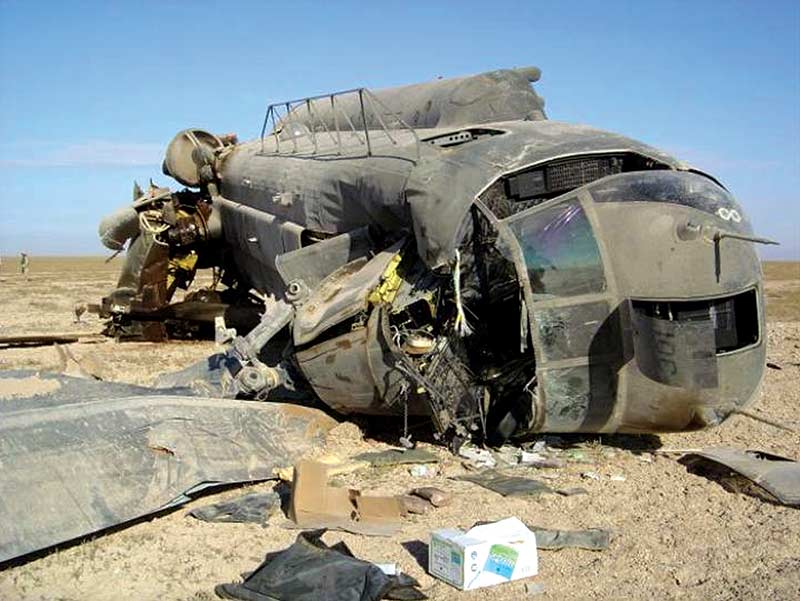You’ll never really know until you get there. We imagine how we might perform when we’re finally facing that really bright light, but we can’t ever be sure. The fine line between selfless valor and rank cowardice is often a diaphanous, ethereal thing. CW4 Ron Bender, however, was the real deal — a true American hero.
The CH-47D Chinook helicopter was flying from Fort Hood, Texas, back to Fort Sill, Okla., with a load of soldiers on board. It was a routine mission, one I have flown myself many times. A tripped chip detector latch on the Number 2 (right-hand) engine transmission was the first indication something was amiss.
A Chinook sports five transmissions and three hydraulic systems. There is a transmission for each rotor system, another for each engine, and a combining transmission to mix everything together. The chip detector consists of a pair of magnetized electrodes across which flows the circulating transmission fluid. If enough ferrous material builds up on the electrodes, the latch trips to inform the flight engineer the transmission requires urgent inspection.
Helicopters being helicopters, the crew found a handy field and set down. The two crewmembers pulled the chip detector, cleaned it off and reinstalled it. They ran up the aircraft and all was well. In accordance with regulations, they could fly the aircraft legally, but they’d need to take a more detailed look once they got home. As they approached the nearby small town of Chico, Texas, at their cruising altitude, the engine transmission disintegrated.
Something Truly Horrible
The affected engine ingested the pulverized transmission and exploded. Turbine wheels spinning at astronomical speeds broke loose and scythed through the aft end of the aircraft, severing hydraulic and fuel lines along the way. The combination of atomized hydraulic fluid and several thousand pounds of jet fuel created a fearsome blaze. The whole rear end of the aircraft was now on fire.
The airflow in a Chinook is from the tail to the nose. This curious phenomenon is the result of Bernoulli’s Effect and the aerodynamic design of the machine. That means smoke and fumes originating anywhere in the aircraft end up in the cockpit. In short order, the accumulated passengers could no longer breathe. Being human, they unfastened and moved toward the front of the aircraft in search of breathable air and a part of the aircraft not on fire.
The First Sergeant for the Chinook unit was along for the ride. He was fit and an impressive specimen. Realizing nothing good could come from having a dozen or so terrified people crammed up into the cockpit while the pilots struggled to maintain control of the burning aircraft, he posted himself in the small passageway leading to the pilots’ station. The 1SG locked his arms on the sides of the passage and was promptly pushed over onto his back. He ended up on the floor with his head on the center console. From this vantage, he had a clear view of both pilots.
The aircraft was in an emergency descent and on fire, yet he reported that the pilots were calm and professional throughout, maneuvering the aircraft to avoid nearby populated areas. The cockpit filled with thick, acrid smoke as the aircraft neared the ground. At that point, everybody on board was a passenger. The massive aircraft slammed into the ground at an estimated 130 knots. That’s roughly 150 miles per hour.
The aircraft bounced up and sideways and then rolled. The cockpit broke free at the forward transmission, spewing gyrating helicopter components liberally across the countryside. The 1SG was unceremoniously ejected at some point, remaining inexplicably intact as he flew through the disintegrating aircraft parts. In one of those quirky little miracles, the man landed on his hands and knees and bounced his head against the ground hard enough to crack the visor cover on his helmet. He was otherwise unhurt.
The Pilot-in-Command, CW4 Bender, was also ejected from the aircraft. The First Sergeant and a few locals reached the dying man still strapped in his seat. His last words were, “Did I miss the little town?” If ever you wondered what a true hero looked like, that was it.
Denouement
Eighteen souls were onboard tail number 86-01643 that fateful afternoon outside of Chico, Texas. Ten of them perished. The post-crash accident investigation fully exonerated the flight crew. In the face of literally unimaginable horror, they all performed magnificently.
Many folks expire peacefully in some facility someplace. Others meet eternity in a more chaotic fashion. On February 25, 1988, CW4 Ron Bender and his crew gave their lives to save a small Texas town. I am simply in awe of such men as these.


